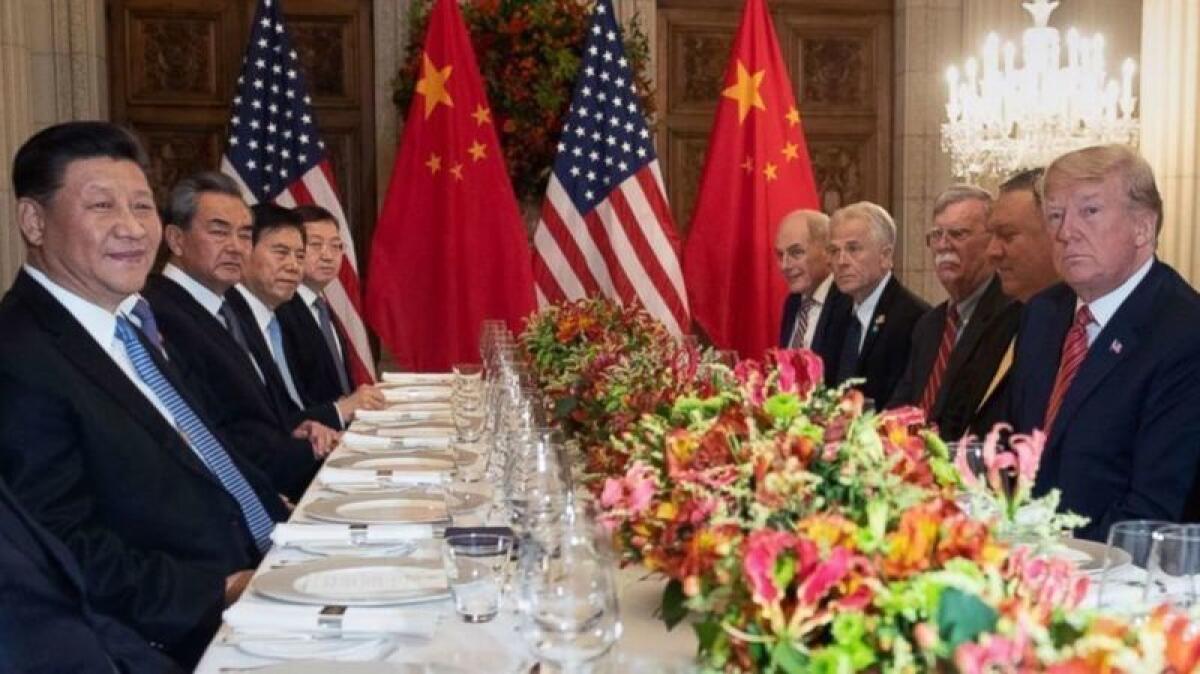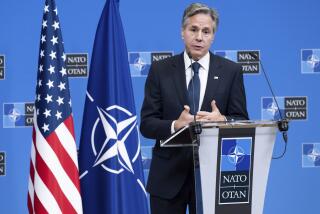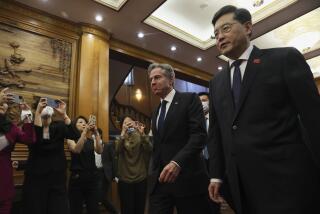U.S. policy toward China shifts from engagement to confrontation

Reporting from Washington — For decades, China had no closer American friend than Dianne Feinstein.
As San Francisco mayor in the 1970s, she forged a sister-city relationship with Shanghai, the first between American and Chinese communities. As U.S. senator, she dined with Chinese leaders at Mao Tse-tung’s old Beijing residence. And in the 1990s, she championed a trade policy change that opened a floodgate of Western investment into China.
Today the Democratic senator sees China as a growing threat, joining a broad array of Trump administration officials, national security strategists and business executives who once favored engagement with Beijing and now advocate a confrontational approach instead.
“I hate to see it all beginning to come apart,” Feinstein said. “That is so hard for me to see ... with all of the hopes that I had between China and this country.”
She has pushed legislation that makes it tougher for Chinese investors to acquire stakes in U.S. firms. And at a recent Senate hearing, she joined other lawmakers in slamming Beijing for cyberattacks and other digital thefts.
Under President Trump’s “America First” policies, the U.S. approach to Xi Jinping’s China has grown more adversarial on multiple geopolitical and economic fronts, much as Washington and Moscow were locked in a power struggle in the Cold War.
But unlike the Soviet Union, China is the world’s second-largest economy and is on track to overtake the United States. Most of the global economy is dependent on what China produces to an extent unimaginable even a decade ago.
Moreover, China is building a modern military, one that within a decade could be capable of challenging U.S. dominance in the western Pacific. Some scholars and military strategists see an inevitable clash as the two countries jockey to project power and influence.
Experts debate whether Washington is falling into what Harvard political scientist Graham Allison calls the “Thucydides trap,” a reference to Athens and Sparta in ancient Greece, when a rising power caused fear in an established power that escalated toward war.
“Should we simply let ourselves fall into the Thucydides trap?” asked J. Stapleton Roy, a retired U.S. diplomat who was ambassador to China from 1991 to 1995. “Or is it possible that with skillful diplomacy, China could be stronger and more prosperous in 2025 and not a strategic threat to the United States?”
How we got here
Trump’s confrontation with China has encompassed far more than a tit-for-tat tariff war.
The U.S. has stepped up naval patrols close to Chinese-claimed islands in the South China Sea, pursued Chinese nationals abroad for allegedly violating U.S. laws, and warned leading American universities about Chinese spies roaming their campuses.
In a harshly worded speech in October, Vice President Mike Pence accused Beijing of employing a “whole-of-government” strategy to undermine the U.S. economy and political system.
On Dec. 20, after the Justice Department indicted two Chinese nationals for directing a global hacking campaign, FBI Director Christopher Wray went further: “China’s goal, simply put, is to replace the U.S. as the world’s leading superpower — and they’re breaking the law to get there,” he said.
These tensions are not new. After President Nixon visited China in 1972, ending the Communist country’s isolation, Washington saw friendly ties with Beijing as a counterweight to Moscow in the Cold War, which ended in 1991.
Over the next two decades, burgeoning economic links gave both countries a stake in getting along. Despite China’s human rights abuses and other irritants, successive U.S. administrations sought to bring Beijing into international accords on trade, nuclear arms and other concerns, arguing that engagement would lead to economic and political reforms.
Accordingly, Washington granted Beijing permanent normal trade relations in 2000, paving the way for China to join the World Trade Organization a year later. U.S.-China trade surged from $5 billion in 1980 to $116 billion in 2000 to $635 billion last year.
By any measure, China’s economic growth has been phenomenal. In a country once stricken by famines, nearly 800 million Chinese have emerged from poverty in recent decades, according to the World Bank.
“After 1978, we never suffered insufficient food supplies,” said Mao Yushi, a prominent economist in Beijing. Mao, 89, remembers when China in 1979 had just two bridges along 2,000 miles of the Yangtze River across the country, from Tibet to Shanghai. Today it has more than 100, he says.
But U.S. policy experts were wrong: The progress did not produce political liberalization or easing of strict economic controls.
China’s soaring trade surplus instead led to growing U.S. complaints about closed markets, unfair state subsidies, theft of intellectual property and manipulation of currency.
Xi came to power in late 2012 as China struggled with reckless economic growth, a backward military and endemic corruption. His answer: exert an iron grip over the Communist Party and assert its dominance over Chinese life.
He backpedaled on pledges to move toward a free-market economy. Instead, he strengthened the role of state-owned companies and party officials who control them.
“Xi’s idea of governance is to follow Mao Tse-tung — less liberty, more control,” said economist Mao, whose call for greater freedoms has left him barred from publishing and lecturing.
Beijing also embarked on an ambitious plan to modernize its military and began building runways and other facilities on man-made islands in the South China Sea, where numerous nations have competing maritime and territorial claims.
Under Xi, China began its “Belt and Road Initiative,” a massive infrastructure program to bolster sea and land links around the globe. It also created the Asian Infrastructure Investment Bank, a multilateral lender like the U.S.-led World Bank, to finance investments in roads, cellphone towers, railways and airports throughout Asia.
The new assertiveness posed a direct challenge to America’s postwar role promoting stability and free trade in the western Pacific. Starting with President Obama, the U.S. response was a slow — and critics say still inadequate and inconsistent — ratcheting up of pressure.
Obama, who called himself the “first Pacific president,” endorsed a strategic pivot to Asia with more military and other resources, but the effort soon faltered. Obama also sought Beijing’s help in blocking Iran from building a nuclear weapon, and in cutting emissions that cause global warming, two priorities for his administration.
Obama’s main countermove was the Trans-Pacific Partnership, a U.S.-led trade deal with most major Pacific Rim countries — except China. The proposed accord was meant to firm up American leadership in the region.
Trump killed the deal when he took office in 2017. He has instead pursued a bilateral, hard-line approach on trade with adversaries and allies alike. Trump also pulled out of the Iran nuclear deal and the Paris climate accord; China stayed in both.
U.S. business leaders who once pushed for access to China’s vast market have seen their hopes fade, leaving almost no one to argue for engagement.
“The private sector no longer sees the profitable opportunities in China that they once did and no longer provides the ballast in the relationship that they once did,” said Abraham Denmark, a former Pentagon official for China now at the Woodrow Wilson International Center for Scholars.
The road ahead
The goal of the Trump administration’s confrontational policy is difficult to discern.
Is it a better trade deal with Beijing or something more? Can Trump persuade Xi to back down from asserting China’s growing power in Asia and beyond?
“We’re on the sidelines lacing up our shoes and we’re not even sure where we’re running,” said Matthew Kroenig, a former CIA and Defense Department official who helped craft Trump’s national security strategy and who supports greater competition with China. “I’ve asked several senior government officials what the goal is and I’ve gotten at least four or five answers.”
Pentagon officials have embraced returning to “big power” competition with major adversaries, including China, part of the White House strategy as it seeks to disentangle from counter-terrorism wars.
These officials openly hope to build up U.S. military power in Asia and elsewhere to deter — or if necessary, to fight — China, a scenario the Pentagon until recently treated as something to plan for but not mention in public.
As a result, they have pushed Congress to fund more ships, planes, missiles and submarines to counter China’s military buildup. They describe clashes between Washington and Beijing as all but inevitable due to their incompatible political systems.
“Chinese senior officials openly express dissatisfaction with the existing world order which they describe as built and led by the U.S., rooted in American or Western values and operating to Washington’s great benefit,” Adm. Philip S. Davidson, the top Pentagon commander in the Pacific, warned in a recent speech to the Center for Strategic and International Studies, a Washington think tank.
“So China is looking to change the world order to one where national power is more important than international law, a system where the strong do what they will, and the weak do what they must,” he added.
John Bolton, Trump’s national security advisor, warned that a state-owned Chinese firm was in discussions to take over port facilities in Djibouti, a strategically located African country on the Red Sea where the U.S. military has a base called Camp Lemonnier.
“Should this occur, the balance of power in the Horn of Africa — astride major arteries of maritime trade between Europe, the Middle East, and South Asia — would shift in favor of China,” he warned.
Senior Chinese officials deny that Beijing is seeking to supplant the United States as the world’s superpower. Some U.S. defense analysts agree, saying China wants to dominate the Asia-Pacific region but that it’s important not to exaggerate Beijing’s ambitions.
“They want enough power to veto certain things that affect them but ... they don’t want to be taking over U.S. bases and the world,” said Oriana Skylar Mastro, a China military expert at Georgetown University and the American Enterprise Institute, a Washington think tank.
“I don’t think they’ll use foreign military interventions as a primary tool for foreign policy as the United States does,” she added. “You don’t have to dominate every region in the world to be a great power.”
Adding to the challenge is Trump’s erratic foreign policy. He has suggested offering trade concessions to China in exchange for pressing North Korea to give up nuclear arms. He has shown disdain for NATO, the United Nations and the World Trade Organization, bulwarks of the global order. He blindsided allies when he announced a unilateral withdrawal of U.S. troops from Syria, a move that led his secretary of Defense to quit in protest.
The isolationist policies have created a vacuum that China and other countries are filling.
“America does not want to lead at a time when China wants to lead,” said Shen Dingli, an international relations professor at Fudan University in Shanghai.
Trump’s withdrawal from the Trans-Pacific Partnership, in particular, is widely seen as having given China, which is the dominant trading partner for every major Asian country, a green light to expand further.
“It would have been very advantageous to us and to our trading partners, so we would have our norms, how we do things like government procurement and protecting intellectual property — rules we want everyone to play by,” said Joseph Yun, a former top American diplomat and until March the State Department’s deputy assistant secretary for Korea and Japan.
The American retreat has forced longtime allies including Japan, South Korea and the Philippines to hedge between Washington and Beijing.
“Most countries do not want to see competition between the U.S. and China to such an extent that they’re forced to choose sides,” said Yun, now a senior advisor at the United States Institute of Peace. “Right now they’re worried that the balance may be tilting and the U.S. is losing interest.”
Whatever the Trump administration’s end game, most experts see China’s rise as irreversible and say the tensions could last for years.
Feinstein, for one, said she hopes the two countries can return to a more cooperative relationship. But she is sober about the chances.
Last August, she disclosed that the FBI had warned her five years earlier that a longtime staffer in her San Francisco office had been secretly feeding unclassified information to the Chinese government. He was fired but not prosecuted.
“We have to have a much fuller relationship with China than we do today,” Feinstein said in an interview. “That used to be there because both sides wanted it. It was part of a learning process. … Now, it doesn’t exist as much.”
Times staff writer Sarah D. Wire in Washington contributed to this report.
Twitter: @dleelatimes
Twitter: @DavidCloudLAT
More to Read
Inside the business of entertainment
The Wide Shot brings you news, analysis and insights on everything from streaming wars to production — and what it all means for the future.
You may occasionally receive promotional content from the Los Angeles Times.











